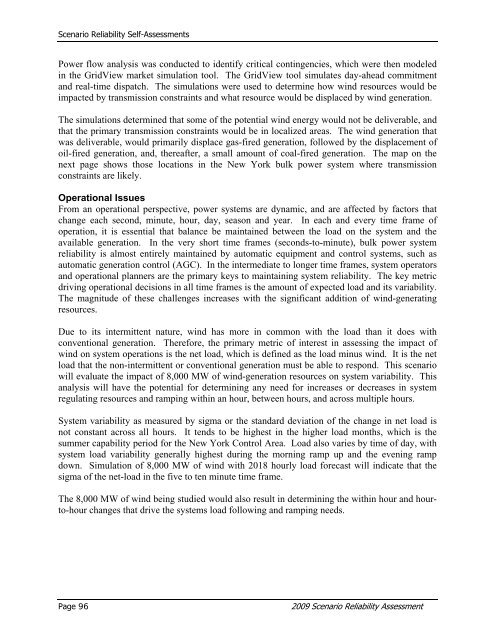2009 Scenario Reliability Assessment - NERC
2009 Scenario Reliability Assessment - NERC
2009 Scenario Reliability Assessment - NERC
- No tags were found...
Create successful ePaper yourself
Turn your PDF publications into a flip-book with our unique Google optimized e-Paper software.
<strong>Scenario</strong> <strong>Reliability</strong> Self-<strong>Assessment</strong>sPower flow analysis was conducted to identify critical contingencies, which were then modeledin the GridView market simulation tool. The GridView tool simulates day-ahead commitmentand real-time dispatch. The simulations were used to determine how wind resources would beimpacted by transmission constraints and what resource would be displaced by wind generation.The simulations determined that some of the potential wind energy would not be deliverable, andthat the primary transmission constraints would be in localized areas. The wind generation thatwas deliverable, would primarily displace gas-fired generation, followed by the displacement ofoil-fired generation, and, thereafter, a small amount of coal-fired generation. The map on thenext page shows those locations in the New York bulk power system where transmissionconstraints are likely.Operational IssuesFrom an operational perspective, power systems are dynamic, and are affected by factors thatchange each second, minute, hour, day, season and year. In each and every time frame ofoperation, it is essential that balance be maintained between the load on the system and theavailable generation. In the very short time frames (seconds-to-minute), bulk power systemreliability is almost entirely maintained by automatic equipment and control systems, such asautomatic generation control (AGC). In the intermediate to longer time frames, system operatorsand operational planners are the primary keys to maintaining system reliability. The key metricdriving operational decisions in all time frames is the amount of expected load and its variability.The magnitude of these challenges increases with the significant addition of wind-generatingresources.Due to its intermittent nature, wind has more in common with the load than it does withconventional generation. Therefore, the primary metric of interest in assessing the impact ofwind on system operations is the net load, which is defined as the load minus wind. It is the netload that the non-intermittent or conventional generation must be able to respond. This scenariowill evaluate the impact of 8,000 MW of wind-generation resources on system variability. Thisanalysis will have the potential for determining any need for increases or decreases in systemregulating resources and ramping within an hour, between hours, and across multiple hours.System variability as measured by sigma or the standard deviation of the change in net load isnot constant across all hours. It tends to be highest in the higher load months, which is thesummer capability period for the New York Control Area. Load also varies by time of day, withsystem load variability generally highest during the morning ramp up and the evening rampdown. Simulation of 8,000 MW of wind with 2018 hourly load forecast will indicate that thesigma of the net-load in the five to ten minute time frame.The 8,000 MW of wind being studied would also result in determining the within hour and hourto-hourchanges that drive the systems load following and ramping needs.Page 96<strong>2009</strong> <strong>Scenario</strong> <strong>Reliability</strong> <strong>Assessment</strong>
















